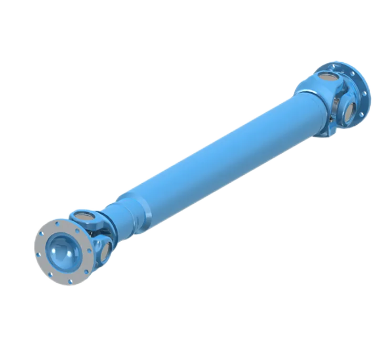Core Definitions: Understanding Flexible and Rigid Couplings
What is a Flexible Coupling?
Flexible couplings are mechanical devices designed to connect two shafts while allowing for some degree of misalignment and movement. They are integral to various applications where changes in alignment due to external factors are anticipated. Common materials used in flexible couplings include rubber, polyurethane, and composite materials, offering both elasticity and durability. Different types of flexible couplings, such as elastic, grid, and beam couplings, serve distinct operational requirements by accommodating various degrees of misalignment. Industries such as automotive, manufacturing, and robotics frequently utilize flexible couplings to manage dynamic shaft alignments and reduce wear and tear on drivetrain components. Flexibility in coupling design ensures operational longevity and efficiency in these demanding sectors. Explore more about [Flexible Couplings](#).
What is a Rigid Coupling?
Rigid couplings are devices that connect two shafts firmly with no allowance for misalignment, allowing efficient torque transmission. Constructed typically from materials like steel and aluminum, they are celebrated for their strength and durability. The various types of rigid couplings, such as sleeve, clamp, and muff couplings, are used in applications where precise shaft alignment is paramount. These couplings are ideal in industries demanding high precision, including aerospace and high-speed machinery, where maintaining positional accuracy is critical to success. Though inflexible in their structure, rigid couplings facilitate robust and uninterrupted power transmission across connected shafts. Explore more about [Rigid Couplings](#).
Functional Differences in Power Transmission
Torque Transmission Capabilities
Torque transmission capabilities differ significantly between flexible and rigid couplings. Rigid couplings facilitate direct torque transfer without energy loss, making them ideal for high precision applications where maximum torque efficiency is crucial. Conversely, flexible couplings, while offering more versatility in alignment, often result in some torque loss due to their inherent flexibility. According to studies, rigid couplings provide superior torque transmission, enhancing system performance across various conditions. For instance, numerical data indicates that rigid couplings can achieve torque transfer efficiency upwards of 95%, whereas flexible couplings may only achieve around 85% in similar applications.
Vibration Absorption and Shock Load Handling
Vibration absorption is integral to machinery health, and flexible couplings excel in minimizing shocks and fatigue, enhancing operational longevity. While rigid couplings transmit vibrations directly through connected shafts, flexible couplings absorb and dissipate these forces, reducing wear and extending the lifespan of machinery components. Comparative data reveals that flexible couplings handle shock loads more effectively, decreasing maintenance costs and improving machine operational efficiency. Industry experts highlight that the vibration absorption capabilities of flexible couplings are pivotal for industries like robotics and manufacturing, where subtle shock absorption can lead to significant improvements in equipment durability.
Misalignment Compensation Mechanisms
Misalignment compensation is a notable advantage of flexible couplings, allowing them to accommodate angular, parallel, and axial misalignments, thus reducing potential machinery wear. This capability is particularly beneficial in industries such as shipping and construction, where exact alignment can be challenging to maintain consistently. Statistics indicate that rigid couplings have higher failure rates in setups where misalignments are prevalent. In contrast, flexible couplings provide resilience against misalignment-induced stress, thereby minimizing downtime and maintenance needs in critical operations.
Industrial Applications and Use Cases
Where Rigid Couplings Excel
Rigid couplings find their niche in industries that demand precision and stability, such as precision machinery, automotive, and aviation sectors. These industries benefit immensely from rigid couplings due to their ability to provide high torque transmission without energy loss, making them ideal for applications where precision and reliability are paramount. For instance, in automotive applications, rigid couplings are crucial in ensuring that power is delivered consistently from the engine to the wheels, maintaining vehicle performance and efficiency. This reliability is further evidenced in aerospace, where any deviation in torque transmission can have severe consequences. A study by the Aerospace Engineering department of MIT highlighted that using rigid couplings in aviation significantly reduced maintenance costs and enhanced system reliability. Thus, in scenarios requiring high torque and minimal maintenance, rigid couplings are the preferred choice due to their robust performance.
Optimal Scenarios for Flexible Couplings
Flexible couplings are particularly advantageous in environments characterized by variable speed drives and vibratory equipment. They excel in settings with high load fluctuations, such as the mining and construction industries, where equipment is subject to constant changes in operational demands. For example, in mining operations, flexible couplings mitigate the impacts of irregular load shifts, enhancing the durability and operational continuity of machinery. In construction, they accommodate unexpected vibrational load changes, reducing downtime and maintenance costs. A case study from the Journal of Construction Engineering showed that implementing flexible couplings led to a 25% reduction in machine downtimes, owing to their superior ability to handle fluctuating loads. This adaptability not only improves system resilience but also ensures reduced operational disruptions, making flexible couplings a strategic choice in dynamic industrial applications.
Performance Trade-Offs: Advantages and Limitations
Benefits of Rigid Couplings in Precision Systems
Rigid couplings offer distinct advantages in high-precision systems, making them a preferred choice in applications demanding tight tolerances and minimal backlash. These couplings ensure a firm and accurate connection between shafts, enhancing the reliability of torque transmission. Data comparing lifecycle performance shows rigid couplings frequently outperform flexible types, particularly in settings requiring exact alignment and low vibration environments. Experts in the field consistently praise the reliability and simplicity of rigid couplings, emphasizing their efficacy in maintaining system integrity where precision is paramount.
Flexible Coupling Advantages in Dynamic Environments
Flexible couplings excel in dynamic environments where fluctuating workloads and vibrations are common. Their ability to accommodate misalignments and absorb shocks makes them essential in machinery with variable speeds or loads. Applications such as mining, construction, and variable speed drives demonstrate the indispensable role of flexible couplings. Studies have highlighted significant savings from reduced maintenance demands and minimized operational disruptions, underscoring the long-term cost-efficiency provided by flexible couplings in these challenging scenarios.
Maintenance Requirements Comparison
When comparing the maintenance requirements of rigid and flexible couplings, flexible types generally necessitate more routine checks due to their operational adaptability. Industry research indicates that, although flexible couplings might present higher maintenance frequency, the overall cost differences over time can lean towards rigid couplings due to potential alignment issues. Both types require vigilant maintenance to prevent failures; improper care can lead to extensive downtimes, as evidenced in cases where neglect of either coupling type caused significant operational setbacks.
Selection Criteria for Optimal Performance
Assessing Torque and Speed Requirements
When selecting a coupling type, assessing torque and speed requirements is crucial to ensure optimal performance in various industries. This evaluation aids in identifying the proper coupling that can maintain operational efficiency without the risk of failure. For example, high-speed machinery in the automotive industry may require couplings that can handle specific torque ranges to minimize wear and tear. Improper alignment in such cases can lead to performance losses, with flexible couplings potentially offering lower torque ratings compared to rigid couplings, which excel in applications requiring high precision. Experts recommend analyzing torque ranges specific to each application and adopting coupling designs to minimize alignment-errors to maintain efficiency.
Evaluating Alignment Conditions
Proper evaluation of alignment conditions is a key criterion for selecting couplings. Misalignment can significantly impact the performance and longevity of couplings, leading to increased wear and potential failures. Tools such as laser alignment systems and dial indicators offer precise measurements, ensuring the coupling operates at peak performance. Data indicates that even minor misalignment can reduce the lifespan of both rigid and flexible couplings significantly. Expert insights suggest maintaining correct alignment practices to avoid downtime and uphold the reliability of the system. Employing these best practices helps ensure the longevity of the machinery and maximizes the performance outcomes.
Environmental Factors and Material Considerations
Environmental factors such as temperature, humidity, and chemical exposure are vital in the selection of coupling materials. These conditions can affect the performance and lifespan of couplings, demanding careful material selection. For instance, aluminum or stainless steel might be chosen for environments prone to corrosion, while high-temperature scenarios might require specific polymers or alloys. Different industries need varied material considerations; for example, oil and gas setups often face extreme temperatures, necessitating heat-resistant materials like stainless steel. Standards and certifications guide material choices and ensure the selected couplings are suited to their operational environment, guaranteeing adherence to industry specifications and safety regulations.
FAQ
What are the main differences between flexible and rigid couplings?
Flexible couplings allow for some degree of misalignment and movement between two connected shafts, making them suitable for environments where such conditions are anticipated. Rigid couplings, on the other hand, provide a firm connection with no allowance for misalignment, ideal for precise torque transmission applications.
Which industries typically use flexible or rigid couplings?
Flexible couplings are commonly used in industries like automotive, manufacturing, and robotics due to their ability to manage dynamic shaft alignments. Rigid couplings excel in aerospace, automotive, and high-speed machinery sectors where precision and stability are crucial.
How do environmental factors influence coupling selection?
Environmental factors such as temperature, humidity, and chemical exposure can affect coupling performance and lifespan. Material selection is critical, with options like aluminum and stainless steel being suitable for corrosion-prone environments, while polymers and alloys may be needed for high-temperature scenarios.

